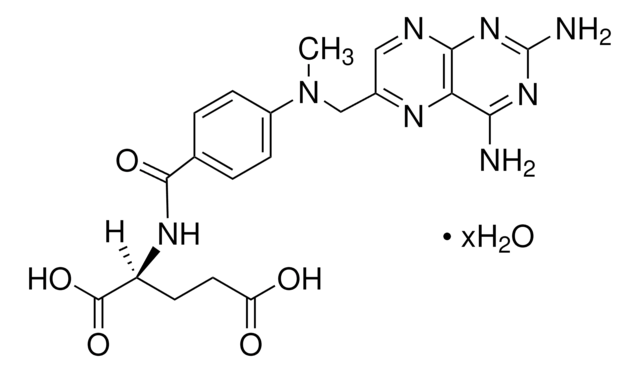M0269
Methotrexat−Agarose
saline suspension
About This Item
Empfohlene Produkte
Biologische Quelle
plant
Qualitätsniveau
Form
saline suspension
Kennzeichnungsgrad
2-7 mg per mL
Methode(n)
affinity chromatography: suitable
Matrix
cross-linked 4% beaded agarose
Matrixaktivierung
cyanogen bromide
Matrixanbindung
carboxyl
Matrix-Spacer
8 atoms
Eignung
suitable for chromatography
Lagertemp.
2-8°C
Anwendung
Physikalische Form
Lagerklassenschlüssel
10 - Combustible liquids
WGK
WGK 3
Flammpunkt (°F)
Not applicable
Flammpunkt (°C)
Not applicable
Persönliche Schutzausrüstung
Eyeshields, Faceshields, Gloves, type ABEK (EN14387) respirator filter
Hier finden Sie alle aktuellen Versionen:
Besitzen Sie dieses Produkt bereits?
In der Dokumentenbibliothek finden Sie die Dokumentation zu den Produkten, die Sie kürzlich erworben haben.
Artikel
This article reviews some of our newest and most innovative technologies and their specific applications toward cancer research. It describes how complex the disease of cancer is, and how difficult it is to identify one topic that is completely unrelated to any other.
This issue of Biofiles reviews some of our newest and most innovative technologies and their specific applications toward cancer research. In preparing this issue of Biofiles, one is reminded how complex the disease of cancer is, and how difficult it is to identify one topic that is completely unrelated to any other.
Unser Team von Wissenschaftlern verfügt über Erfahrung in allen Forschungsbereichen einschließlich Life Science, Materialwissenschaften, chemischer Synthese, Chromatographie, Analytik und vielen mehr..
Setzen Sie sich mit dem technischen Dienst in Verbindung.




